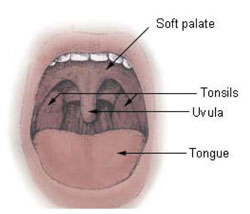The oral cavity
Oral hygiene is the practice of keeping the oral cavity (lips, tongue, teeth, throat and surrounding structures, Figure 6.1) clean and healthy to prevent tooth decay and gum disease.

The oral cavity is the entrance to the digestive tract and the respiratory system (look back to Figure 2.2 in Study Session 2 and Figure 4.1 in Study Session 4). A healthy oral cavity has smooth, unbroken lips without any sores. The teeth are not broken or cracked; they are clean and without signs of decay. The tongue and gums are clean and pink, without any greyish coating, bleeding, sores or swelling. The saliva that keeps the mouth moist should be a clear fluid, not thick or coloured white or greenish, which is a sign of infection. The breath emerging from the mouth should be without any smell.
In addition to the teeth, the other structures that aid chewing of food are the lips, cheek muscles, tongue, the roof of the mouth (hard palate), the soft palate (see Figure 6.1) and the uvula. The tonsils are small organs in the throat, containing white blood cells, which help to prevent infection entering the body through the mouth.